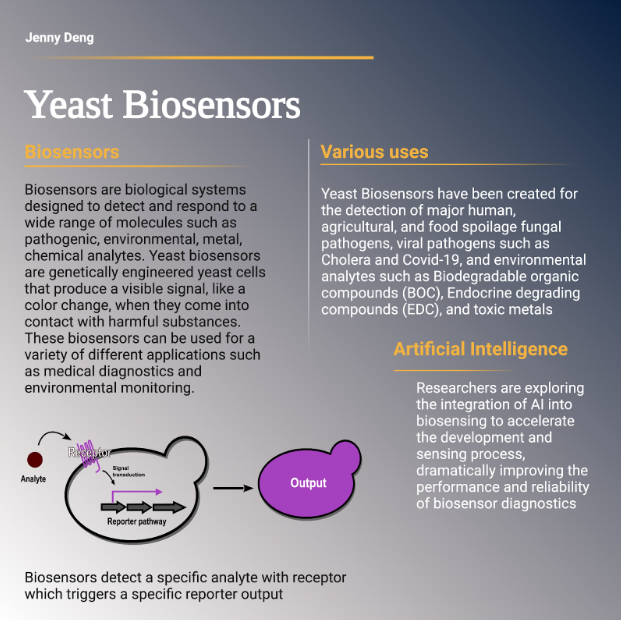Yeast, an unassuming organism commonly known for its roles in winemaking and breadmaking, holds remarkable potential beyond the kitchen. Commonly known as baker’s yeast, Saccharomyces cerevisiae is an ideal tool for molecular engineering due to its low-cost production and genetic modifiability. Yeast can be the future of environmental monitoring, detecting pollutants in the air, telling you the presence of toxic chemicals in your soil or drinking water. It can be the future of medical diagnostics, providing on site diagnostics, quicker, cheaper, and more easier than any PCR test you may get at your doctor’s office. And all of this can be done with the same yeast biosensing technology.
So what are biosensors? Biosensors are biological systems designed to detect and respond to a wide range of molecules such as pathogenic, environmental, metal, chemical analytes. Yeast biosensors are genetically engineered yeast cells that produce a visible signal, such as a color change, when they come into contact with harmful substances. They work by coupling yeast with a specific receptor and a reporter. The receptor is responsible for detecting a specific analyte, and once detected, the reporter will produce an easily measurable output (Jarque, 2016).
The receptors in these biosensors are typically engineered proteins that can specifically bind to the target molecule. Once the receptor detects the molecule, the biosensor will produce a signal that can come in the form of fluorescence, luminescence, or colorimetric outputs, depending on the biosensor type (Adeniran, 2015). The type of receptor and reporter are interchangeable, making it adaptable for the detection of various analytes (Tetyana, 2021).
A recent study demonstrated the development of yeast biosensors for detecting fungal pathogens. They first started with C. Albicans, a pathogenic fungus that can cause infections in humans. To create the receptor, they took advantage of the natural signaling pathway in yeast by using G-coupled protein receptors (GPCRs) (Nature Education, 2010). A molecule specific receptor was created by using the mating receptor GPCR of the fungal pathogen. To this, they added a red lycopene readout, so when in contact with the pathogen’s mating peptide, the biosensor will create a red color visible to the naked eye. Using this technology, researchers created biosensors for 10 major human, agricultural, and food spoilage fungal pathogens (Ostrov, 2017). This has further been expanded to the detection of viral pathogens such as Cholera and Covid-19.
Not only can this technology be applied for the detection of pathogens, it has also been used for the use of detecting environmental analytes. Yeast Biosensors have been developed for Biodegradable organic compounds (BOC), Endocrine degrading compounds (EDC), and toxic metals (Jarque, 2016). Yeast biosensors are increasingly being used in environmental monitoring to detect pollutants such as heavy metals, pesticides, and toxins in water, soil, and air.
Unlike traditional chemical tests, yeast biosensors are biodegradable and environmentally friendly, reducing the risk of additional contamination. Their ability to continuously monitor environments without the need for expensive equipment makes them an innovative and practical tool for protecting ecosystems and public health.
While developing these yeast biosensors ,it’s not as easy as switching shoes, in the future it can be. Currently, a significant limitation in the development of yeast biosensors is the long turnaround time, often spanning several months, which poses a barrier to rapid commercialization. To address this, researchers are exploring the integration of AI into biosensing to accelerate the development and sensing process, dramatically improving the performance and reliability of biosensor diagnostics (Flynn, 2024). AI can be integrated into the biosensor development process, helping to choose target molecules, create detection components, improve signal detection, and analyze data. This AI-driven approach could reduce the development time to as little as three months, making it feasible to produce customized biosensors on demand. Analytes and outputs can be easily switched, enabling the rapid development of tailored yeast biosensors to meet a wide range of detection needs.
Using this biosensing technology, receptors and reporters can easily be developed and switched for detection uses. As research continues to advance, we can expect to see even more innovative applications of these biosensors, further showcasing the incredible capabilities of this unassuming organism.

References
[1] Nature Education. "GPCR." Nature Education, 2010, www.nature.com/scitable/topicpage/gpcr-14047471/.
[2] Ostrov N, Jimenez M, Billerbeck S et al. A modular yeast biosen- sor for low-cost point-of-care pathogen detection. Sci Adv 2017;3:e160322.
[3] Jarque S, Bittner M, Blaha L, Hilscherova K. Yeast Biosensors for Detection of Environmental Pollutants: Current State and Limitations. Trends Biotechnol. 2016 May;34(5):408-419. doi: 10.1016/j.tibtech.2016.01.007. Epub 2016 Feb 12. PMID: 26875975.
[4] Adeniran A, Sherer M, Tyo KE. Yeast-based biosensors: design and applications. FEMS Yeast Res. 2015 Feb;15(1):1-15. doi: 10.1111/1567-1364.12203. Epub 2015 Jan 14. PMID: 25154658.
[5] Flynn CD, Chang D. Artificial Intelligence in Point-of-Care Biosensing: Challenges and Opportunities. Diagnostics (Basel). 2024 May 25;14(11):1100. doi: 10.3390/diagnostics14111100. PMID: 38893627; PMCID: PMC11172335.
[6] Tetyana, P., Sumbula. P, Njengele-Tetyana, Z., Biosensors: Design, Development and Applications, Nanopores, 2021, 10.5772/intechopen.97576
